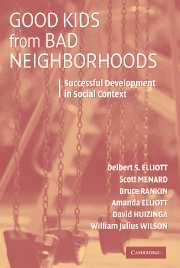Book contents
- Frontmatter
- Contents
- List of Tables and Figures
- Foreword by Richard Jessor
- Acknowledgments
- 1 Growing Up in Disadvantaged Neighborhoods
- 2 Growing Up in Denver and Chicago: The MacArthur Neighborhood Study
- 3 Good and Bad Neighborhoods for Raising Children
- 4 The Effects of Growing Up in a Bad Neighborhood: Initial Findings
- 5 Critical Dimensions of Neighborhood Organization and Culture
- 6 The Effects of Neighborhood Organization and Culture
- 7 Family Influences: Managing Disadvantage and Promoting Success
- 8 School Climate and Types of Peer Groups
- 9 What Matters Most for Successful Youth Development?
- 10 Successful Development in Disadvantaged Neighborhoods
- Appendix A
- Appendix B
- References
- Author Index
- Subject Index
4 - The Effects of Growing Up in a Bad Neighborhood: Initial Findings
Published online by Cambridge University Press: 06 August 2009
- Frontmatter
- Contents
- List of Tables and Figures
- Foreword by Richard Jessor
- Acknowledgments
- 1 Growing Up in Disadvantaged Neighborhoods
- 2 Growing Up in Denver and Chicago: The MacArthur Neighborhood Study
- 3 Good and Bad Neighborhoods for Raising Children
- 4 The Effects of Growing Up in a Bad Neighborhood: Initial Findings
- 5 Critical Dimensions of Neighborhood Organization and Culture
- 6 The Effects of Neighborhood Organization and Culture
- 7 Family Influences: Managing Disadvantage and Promoting Success
- 8 School Climate and Types of Peer Groups
- 9 What Matters Most for Successful Youth Development?
- 10 Successful Development in Disadvantaged Neighborhoods
- Appendix A
- Appendix B
- References
- Author Index
- Subject Index
Summary
SYNOPSIS
How much difference does it make if one grows up in a disadvantaged neighborhood as compared to an affluent neighborhood? Does living in a physically deteriorated neighborhood as compared to a well-cared-for neighborhood undermine a successful course of development? These are the questions answered in this chapter, testing the model of neighborhood effects outlined in the last chapter.
We used two measures of successful development that were common to both Denver and Chicago: Prosocial Competence and Problem Behavior. The first is a composite measure combining five subscales measuring school grades, prosocial activities, self-efficacy, importance of school and work, and expected educational attainment. The second is a negative indicator and includes self-reports of delinquent behavior, drug use, and arrests. Three additional success measures are used for Denver. Personal Competence and Prosocial Behavior are expanded versions of Prosocial Competence, separating attitudinal indicators of competence from behavioral indicators and including several additional subscales. The final measure, On Track, measures the probability that a youth is “on track” developmentally for making a successful transition into adult roles.
Three classifications of neighborhoods are developed based on levels of income (Advantaged, Moderate, and Poor), disadvantage (Advantaged, Modest, and Disadvantaged) and deterioration (Deteriorated and Well-Kept). The appropriateness of using racial mix as an indicator of neighborhood disadvantage is examined and confirmed. Disadvantage is more strongly related to youth development than Poverty alone when compared on the Denver site.
- Type
- Chapter
- Information
- Good Kids from Bad NeighborhoodsSuccessful Development in Social Context, pp. 55 - 100Publisher: Cambridge University PressPrint publication year: 2006



